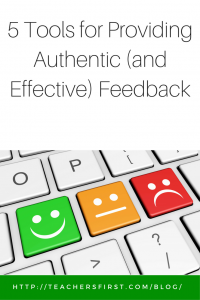 Research has long proven that providing students with authentic and timely feedback improves student performance and learning. In fact, the authors of this study concluded that “Feedback is among the most critical influences on student learning.”
Research has long proven that providing students with authentic and timely feedback improves student performance and learning. In fact, the authors of this study concluded that “Feedback is among the most critical influences on student learning.”
Many sites and online tools offer help with providing feedback to learners; in fact, the number of choices may become overwhelming. As you search for online tools, here are items to consider:
- What type of work are you assessing?
- Does this resource fit into your level of comfort with technology?
- Will this work on any device you use?
- How easy is it to share with your students?
- Will it provide the flexibility you need to provide the type of feedback you desire?
The following suggestions may help as you begin searching for the proper tool to provide online feedback. Links take you directly to the TeachersFirst review of each resource. Each review includes a short description of the site along with suggestions for classroom use. A quick look at the suggested grade levels and technology comfort level should help you quickly decide whether it is something that might be worth investigating for use in your classroom.
- Kaizena is an audio tool for providing feedback on written documents. Highlight any section of the document, record, and provide your feedback. Kaizena works best with Google Drive.
- Thinglink allows users to add comments to images and video. Take a picture of any piece of student work, add comments, and share with your student. Thinglink is perfect for all subjects. For example, as math teachers provide feedback on problems – highlight specific areas where the student misunderstanding takes place and discuss the next steps.
- NowComment is another tool for use with documents. Turn your text into an online conversation (be sure to use privacy settings) between you and your student.
- Recap uses video to assign and assess work. Create your class to monitor assignments, have students reflect on work, and provide feedback.
- Seesaw is a digital portfolio tool that provides students to upload and reflect upon work. Use the audio features to help students to reflect on their learning and share insight into their thought process. Seesaw also offers the option to engage in dialogue with students about their responses.
As you think about providing the most effective feedback to your students, here are some ideas to consider:
- Instead of immediately assigning a letter grade to student work, give the student suggestions for taking their work to the next level. Allow students the option to resubmit work based on your feedback. One teacher I know reported a 50% increase in resubmitted work when using this technique!
- Students love video games because feedback is instantaneous, they recognize problems immediately and begin problem-solving to move forward. In fact, students quickly abandon games that are too easy, proving they don’t mind a challenge. Use this information to your advantage, provide feedback as soon as possible and encourage students to challenge themselves in their work.
- Try to avoid focus on grades; feedback should move students toward learning – not toward achieving the highest grade.
- Provide feedback that allows for an explicit action that leads to improvement. For example, when assessing a complex math problem, provide your students with information on the portion where they may have gone wrong. Specific clarification of problematic issues provides students the opportunity to move forward from the right place, instead of wondering where they went wrong.
- Use rubrics to help provide feedback. Effective rubrics contain specific expectations and are a natural tie-in to providing authentic feedback.
Serious consideration of the right tool to give feedback along with the careful wording of content is a necessary part of effective classroom instruction. Positive, yet constructive feedback will encourage students to try harder and become more engaged in the process of learning.
What has been most successful in your classroom when providing effective feedback? Please share your ideas in the comments below.


Thank you for this post. I especially appreciated that feedback should move students toward learning